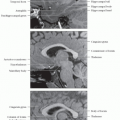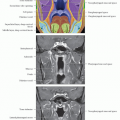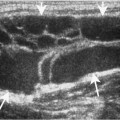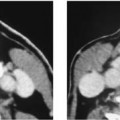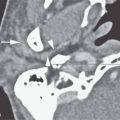Brainstem and Cerebellum Overview
Charles R. Carrasco, MD
Karen L. Salzman, MD
Terminology
Synonyms
Classical nomenclature (simplified nomenclature)
Superior (tentorial), inferior (suboccipital), anterior (petrosal) cerebellar surfaces
Primary (tentorial), horizontal (petrosal), prebiventral/prepyramidal (suboccipital) cerebellar fissures
Definitions
Posterior fossa: Houses brainstem and cerebellum, below tentorium cerebelli (infratentorial)
Brainstem: Composed of midbrain (mesencephalon), pons and medulla oblongata
Cerebellum: Largest part of hindbrain, integrates coordinations & fine-tuning of movement & regulation of muscle tone
Gross Anatomy
Overview
Posterior fossa: Infratentorial contents
Protected space surrounded by calvarium, contains:
Brainstem anteriorly, cerebellum posteriorly
Cerebral aqueduct and fourth ventricle
CSF cisterns containing CNs, vertebrobasilar arterial system and veins
CSF cisterns suspend & cushion brainstem and cerebellum
Brainstem
Anatomic divisions
Midbrain (mesencephalon): Upper brainstem, connects pons and cerebellum with forebrain
Pons: Mid portion of brainstem, relays information from brain to cerebellum
Medulla: Caudal (inferior) brainstem, relays information from spinal cord to brain
Functional divisions
Ventral part: Contains large descending white matter tracts: Midbrain cerebral peduncles, pontine bulb, medullary pyramids
Dorsal part: Tegmentum, common to midbrain, pons and medulla; contains CN nuclei and reticular formation
Cerebellum
Two hemispheres & midline vermis, three surfaces
Connected to brainstem by three paired peduncles
Cortical gray matter, central white matter & four paired deep gray nuclei
Anatomy Relationships
Posterior fossa boundaries
Tentorium cerebelli superiorly
Bony clivus anteriorly
Temporal bones and calvarium laterally
Foramen magnum and calvarium inferiorly
Midbrain
Ventral: Cerebral peduncles (crus cerebri) containing corticospinal, corticobulbar and corticopontine tracts
Dorsal tegmentum: Ventral to cerebral aqueduct
White matter tracts: Medial longitudinal fasciculus, medial lemniscus, lateral lemniscus, spinothalamic tract, central tegmental tract
Gray matter: Substantia nigra and red nucleus
Upper midbrain: Contains CN3 nucleus, at superior colliculus level
Lower midbrain: Contains CN4 nucleus, at inferior colliculus level
Tectum (quadrigeminal plate): Dorsal to cerebral aqueduct
Superior & inferior colliculi
Periaqueductal gray matter
Pons
Ventral: Longitudinal fibers primarily from corticospinal, corticobulbar & corticopontine tracts
Dorsal tegmentum: White matter tracts & CN nuclei
Medulla
Ventral: Olives & pyramids
Dorsal tegmentum: White matter tracts & CN nuclei
Stay updated, free articles. Join our Telegram channel

Full access? Get Clinical Tree


